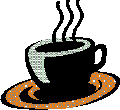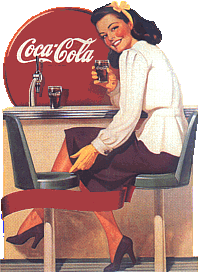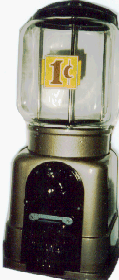
In addition, the mass
exodus from the city to the suburbs
contributed to the demise of the soda
fountain.
People felt safer living on the out
skirts of town, were neighborhoods were
newer, and crime was lower. They simply
didn't live close enough to the old soda
fountains to visit them like they used
to, and when they went shopping they
went to the mall. The kids also started
hanging out at the malls, instead of the
neighborhood soda fountain.
These are just some of the reasons that
the old neighborhood soda fountains
ceased to exist.
There seems to be several reasons for
the use of these calls. The main reason
had to do with shortening the time to
place an order, and more importantly to
help remember orders. It's human nature
to remember things that are kind of
funny, and most of these calls are
amusing.
Another reason had to do with protecting
the feelings of the customers. If a
customer quietly ordered a dose of
citrate of magnesia, they probably would
not appreciate a soda jerk announcing
this to the rest of the patrons, so the
discreet call of 'Mary Garden' would be
used instead.
Other owners did
not want their employees to use the
calls, particularly as some of their
employees began to use colorful terms
like 'Dog and maggot' for crackers and
cheese.
By the mid-1930's the use of these calls
were on the wane. This coincided with
the small drug stores, and diners that
contained the soda fountains being
purchased by the larger chains. The
large chains felt that the use of these
calls were unprofessional. Fortunately,
there were two articles written that
have recorded many of these calls for
prosperity. "Linguistic Concoctions of
the Soda Jerker" was an article written
in 1935 for American Speech by Harold W.
Bentley. The expressions he
recorded
were from a large variety of soda
fountains in the New York City area.
Michael Owen Jones wrote the article
"Soda-Fountain, Restaurant, and Tavern
Calls" for Indiana University. For this
article he had interviewed Paul Sinclair
who had worked as a waiter for the
Jayhawk Cafe, of Lawrence, Kansas,
before WWII, and was the owner of the
Jayhawk from 1946 to 1964. The calls
used at the Jayhawk were in use from
about 1937 (possibly earlier) to 1964
when Mr. Sinclair sold the cafe and the
calls came to an end.
Many of the expressions that were used
in one soda fountain would also be used
in other soda fountains across the
country. However, this was not always
the case. Some calls occasionally had
different meanings in different soda
fountains, and it was common for a
single item to have several expressions.
'Black and White' might have been a
'coffee with cream' in one place, and a
'chocolate malted milk' in another.
Furthermore, a hot chocolate might be a
'Lacey Cup' in one soda fountain, and a
'Snow Shoe' in another.
Regular customers also became acclimated
to the calls and often started using
them, thus helping to perpetuate them.
They could also effect a
change in the
calls. For instance, 'eighty-one' was
the traditional call for a glass of
water. Since a glass of water was one of
the first things a waiter would provide
a customer, as soon as a customer came
into the soda fountain, a call of
'eighty-one' would go out. The customer
mistook this call to mean 'a customer
needed service' and that was how they
started using the call (they would sit
down and yell out
'eighty-one').
Lastly, the calls were not limited to
just the items ordered. There were also
calls for the number of items in the
order, the size of items ordered,
special instructions, and miscellaneous
calls. When all these calls where put
together an order would be formed. As an
example "burn a crowd of van." Burn is a
malted milk shake and it is assumed to
be chocolate. A crowd is three, as in
three's a crowd. Van is vanilla. So burn
a crowd of van is "Three vanilla malted
milk shakes." It was also assumed
that shakes
and malts are chocolate flavored, Cokes
are plain, and coffee is with cream.
These calls are rare now, but still
remain in long-time popular diners or
small luncheon bars where the clientele
are often 'regulars' and the atmosphere
relaxed. If you know of one, you are
enjoying a treat many, especially
younger, people today have never tasted!

There have been plenty of television
shows and movies where a customer is in
an old diner and he orders something
like a ham sandwich and the waitress
yells to the cook 'Dress one pig.' These
calls, which have all but died in real
eating establishments, actually got
their start in soda fountains and from
there moved to diners.

'Java', please, and I
don't mean
a computer language to be invented 30
years into the future,
Maybelle:-)
The oldest
recorded instance of a soda
fountain call is attributed to
preacher/orator Henry Ward Beecher
(1813-1887). He enjoyed witnessing the
resourcefulness of soda dispensers, and
on one occasion decided to put one of
these dispensers to a test. Mr. Beecher
ordered two eggs on toast. The dispenser
called to the cook with 'Adam and Eve on
a raft.' Mr. Beecher then quickly asked
to have the eggs scrambled, and without
hesitation the dispenser shouted 'and
wreck 'em.'
Adam and Eve on a raft
and
kill two pigs,
mmmm! Another
use of these calls would be to
alert co-workers to certain situations
without announcing the situation to the
customers. A call of 'Ninety-five' would
be an alert to co-workers that a
customer is walking out without paying
his bill. Likewise, a call of 'Fix the
pumps' would let co-workers know to
check out the girl with the large
breasts!
Some of the owners of soda fountains
(and diner's) liked the use of these
calls as they provided many benefits and
they provided a little color to the
common place.
Another
use of these calls would be to
alert co-workers to certain situations
without announcing the situation to the
customers. A call of 'Ninety-five' would
be an alert to co-workers that a
customer is walking out without paying
his bill. Likewise, a call of 'Fix the
pumps' would let co-workers know to
check out the girl with the large
breasts!
Some of the owners of soda fountains
(and diner's) liked the use of these
calls as they provided many benefits and
they provided a little color to the
common place.
'Sundae van,
please'
The structure of the calls was generally
in the order of the item, the number of
items, the size, any special
instructions, and miscellaneous.
However, considerations of brevity and
clarity often determined the way in
which separate items were united into a
complete call; thus, a small glass of
Coca-Cola is 'shoot one' and lemon
flavor is 'to the left', but for a lemon
flavored Coke, the call is 'shoot a
left'.






 The coin-operated industry began in 1931
with the production of 'Ballyhoo'. It
was built by Raymond Maloney, who later
founded the Bally manufacturing company.
It was not until 1936, however, THAT the
term "pinball" was coined. In 1934, the
infamous tilt mechanism was devised.
The coin-operated industry began in 1931
with the production of 'Ballyhoo'. It
was built by Raymond Maloney, who later
founded the Bally manufacturing company.
It was not until 1936, however, THAT the
term "pinball" was coined. In 1934, the
infamous tilt mechanism was devised.
 People realized
they could manipulate the game to their
advantage by shaking it, so
manufacturers had to come up with a way
to stop the cheating.
People realized
they could manipulate the game to their
advantage by shaking it, so
manufacturers had to come up with a way
to stop the cheating.
Supposedly, one of the ideas that did not make it into production was pounding sharp pins or nails onto the side and bottom of the machine (this was quickly rejected on the assumption that players would get so angry that they would really inflict some damage on the machine.) One of the earliest implementations involved a ball on a pedestal that would fall off when the machine was moved around too much.
On modern machines, there are two tilt sensors: the standard movement tilt and the slam tilt. Slam tilts are used to detect major abuse (such as slamming your hand into the front of the coin door or dropping the machine) and are just a couple of leaf switches that signal a slam when they touch each other. The movement tilt is detected by a pendulum and bob mechanism that moves around inside a ring. A tilt (or tilt warning) occurs when the metal pendulum rod touches the metal ring.
1947 was the big year. Humpty Dumpty- the first game with flippers -was released by Gottleib. The flippers were not set up as we know them today, however. There were three sets of two flippers located at three different spots going up the playfield. They were facing each other, as flippers do today, but the pivot point was at the bottom of the flippers.
In January 1948, a company called 'Genco' placed the flippers at the bottom of the playfield in their game 'Triple Action'. The configuration was still a little unusual: the flippers were facing outward, not inward.
The first game that had the flippers set up as we know and love them today was probably 'Spot Bowler', a 1950 Gottleib game. If you have not seen one of these older games, you might be surprised at the size of their flippers. They were about the size of two pinballs in length, much like some of the small flippers used in today's games (such as the leftside flipper on 'The Addams Family').
It was not until 1970 that games started using the longer flippers on a regular basis. One of the darkest days in pinball history came about on January 21, 1942. Pinball was banned in New York City because it was viewed as a game of luck rather than a game of skill (ergo, playing pinball is gambling!). To "celebrate" the ban, Mayor Fiorello Henry LaGuardia (as in LaGuardia airport) smashed a number of machines in front of a largely supportive crowd.
The ban lasted until 1976. Free games (replays, matches, etc.) continue to be illegal in New York City to this day, although the law goes unenforced.
In 1960 the idea of an earnable extra ball first appeared in Gottleib's 'Flipper'. This was done in response to the laws of many areas that made it illegal to award replays. The first drop targets were introduced in Williams' 'Vagabond' game in 1962.
The next major change came in 1975. The first non-relay-based game, called 'Spirit of 76', was produced by Micro. It marked the beginning of the switch from electromechanical to solid state games. The first widely available solid state game (only 100 'Spirit Of 76's' were made, mostly due to an unattractive playfield) was Freedom from Bally in 1976.
Many games in the 1976-1979 period were made in two versions (both solid state and electromechanical) as manufacturers refined the process of moving to the new technology. In 1979, the first talking game was produced: 'Gorgar', from Williams. In the early 1980's, many games started using magnets to let their player try and save the ball (called 'magna-save' by Williams). 'Black Knight' and 'Jungle Lord' are two good examples of this.
The next major
revolution in pinball was not until
1991, when Data East came out with the
first dot-matrix display in their game
'Checkpoint'. Starting around 1992, all
games from all manufacturers have
employed a dot-matrix display.
Pinball has come a long way in the last six years or so, particularly in complexity. It will also continue to advance with the technology. One important advent in pinball history is the introduction of pinball simulations on home computers. While there are some good simulations out there, nothing beats the feel of having a full-sized machine in front of you with real bells, buzzers and flippers.

This article is taken from the front page of 'Antiques & Auction News', Friday, September 20, 1996: "Vintage Games Arcade Adds Fun To Antiques Market" by Scott Wood
At one end of the Old Sled Works Antique
and Craft Market in
Duncannon, Pennsylvania,is a room of
happy machine-made memories. Jimmy
Rosen, proprietor of the market, has
built an arcade filled with machines
ranging in age from the 1920's era to
the late 1960's. Presently, there are
more than 50 games in the arcade, almost
all ready to work for a quarter or a
dime. Along
the wall,
facing the
rows
of old games, is a 1950-style soda
fountain. The counter, stools, freezers,
and ice-cream dispensers once belonged
to a fountain in nearby Harrisburg,
Pennsylvania. A small seating area
forms an alcove at the end of the
fountain counter, and the chairs and
tables are classic 1950's furniture -
futuristic assemblies of chrome, vinyl,
and glass table tops. Under the glass
table tops, for diners to view and
reminisce are old photographs of area
businesses, old city scenes,
advertisements, and old 45
records. Princess Doraldina, the
Fortune-teller. Most slot machines were
to view things, not to gamble, in the
penny arcades.
Princess Doraldina, the
Fortune-teller. Most slot machines were
to view things, not to gamble, in the
penny arcades. A new 45 by the Martini Brothers, a
popular local trio that plays music from
the 1950's, occupies a central spot
under the glass of one of the tables.
The cover photograph of the record
(featuring the three musicians) was
taken at the fountain counter. The
entire room is like a 'time warp.'
There seems to be no end to the detail
that's been covered, and nearly
everywhere one looks, there are early
advertisements, and mementos that
include ticket stubs to amusement parks,
match covers, news clippings and other
commonplace items, all from the 1950's
and 1960's.
A new 45 by the Martini Brothers, a
popular local trio that plays music from
the 1950's, occupies a central spot
under the glass of one of the tables.
The cover photograph of the record
(featuring the three musicians) was
taken at the fountain counter. The
entire room is like a 'time warp.'
There seems to be no end to the detail
that's been covered, and nearly
everywhere one looks, there are early
advertisements, and mementos that
include ticket stubs to amusement parks,
match covers, news clippings and other
commonplace items, all from the 1950's
and 1960's. Test
your grip by shaking hands with Uncle
Sam
Test
your grip by shaking hands with Uncle
Sam
The arcade gives the Old Sled Works something that distinguishes it from the many antiques and collectibles markets in the region, Rosen states. "Along with our wonderful dealers and their merchandise, the arcade is a tangible advertisement - a great draw!" The building that Rosen's market occupies already sets it apart from other markets. The long brick structure was once the Standard Novelty Works, which produced Lightning Guider Sleds.
The building was designated a
Pennsylvania Historic Site in 1992, and
an official blue and yellow marker
bearing a brief history of the place is
posted outside the market.
'The Works' was once one of the busiest
and best-known makers of children's
sleds in the country. Lightning Guider
sleds were made by workers from 1904 to
1988. The plant was credited with
producing more sleds than any other
American factory during the 1920's and
1930's, turning out 1,600 to 1,800 sleds
a day.
Wow,
only a
penny! No wonder they're all
gone.
"The Old Sled Works is an antiques and crafts market first and foremost. But the arcade is like one of those old-fashioned soda fountain desserts," says Rosen. "It is very pleasurable to see fathers and their children come in and play the games - all the while the father telling his children about games of his youth. The games can really open the door of memories.
